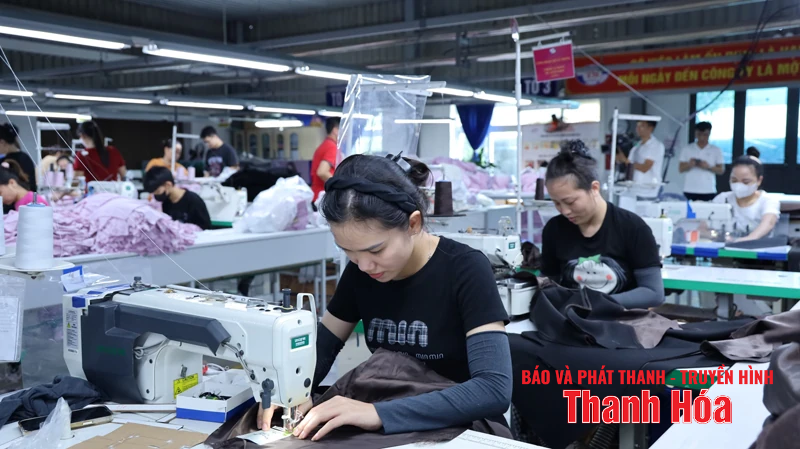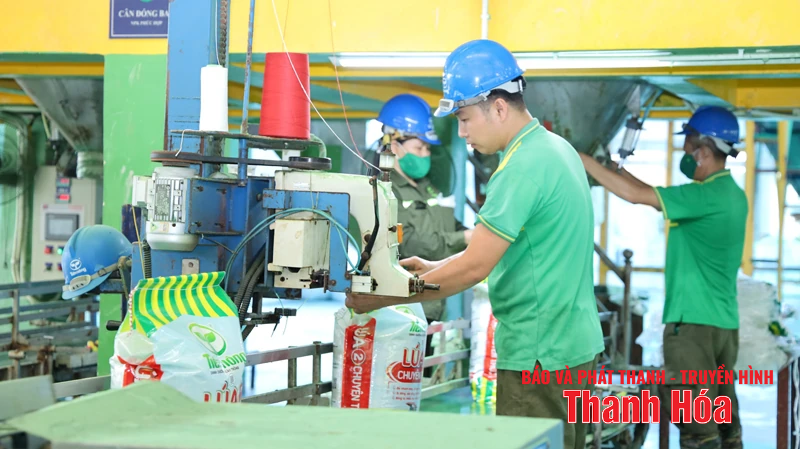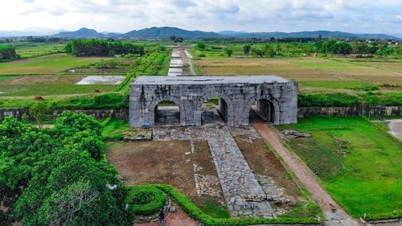Workers at Tien Son Group Joint Stock Company produce garments for export.
Clear motion
During the 2021-2025 period, Thanh Hoa's industry will continue to affirm its leading role in the economic structure. The value added of the industrial sector (VACN) is projected to grow at an average rate of 17% per year, reaching 21.67% in 2024 – a rare increase given the investment and market challenges faced by many localities. The proportion of VACN in the province's GRDP is expected to increase from 29% (in 2020) to 39% (in 2025), reflecting the increasingly prominent leading role of the manufacturing sector.
Notably, the internal structure of the industrial sector has undergone a significant shift from extraction and raw material production to processing and manufacturing. The proportion of processing and manufacturing within the sector increased from 75.2% (in 2020) to 79.4% (in 2025), showing clear signs of a shift from extensive development such as expanding scale and attracting unskilled labor to intensive development, applying technology, increasing value and productivity.
A concrete example is that during the 2020-2025 period, a series of new industrial projects with higher technological content and larger scale came into operation, such as: Nghi Son 2 Thermal Power Plant (1,200 MW), Long Son Cement Plant lines 3 and 4, Miza Packaging Factory, SAB Vietnam Industrial Plant, along with many automated leather, footwear, and textile facilities. In particular, the petrochemical industry not only accounts for a large proportion of production but also provides a foundation for industries processing post-petroleum products such as propylene and synthetic resins.
During this period, many factories continuously invested in technology and expanded production scale to enhance product competitiveness and target export markets. A prime example is the Tien Nong Bim Son Plant Nutrition Factory (belonging to Tien Nong Agricultural and Industrial Joint Stock Company), which recorded positive production results in the first six months of 2025, with output exceeding 100,000 tons and revenue surpassing 800 billion VND. According to Mr. Nguyen Chi Thanh, deputy director of the factory, the unit's goal for the last six months of the year is to complete the annual plan with an output of nearly 200,800 tons. To realize this goal, the factory is focusing on strongly applying scientific and technological advancements, especially implementing a fully automated fertilizer production process using BIOC technology. This not only contributes to improving productivity and product quality, but also optimizes operational efficiency, aiming for sustainable development and increased competitiveness in the market.
Shaping depth
Despite achieving many positive results in structural transformation and affirming its role as a driving force, Thanh Hoa's industrial sector still faces several bottlenecks that need to be addressed promptly to maintain sustainable growth in the coming period.
Notably, there has been a decline in output in several traditional industries, clearly reflecting challenges related to technology, raw materials, and markets. In the first seven months of 2025, alongside products with increased output such as iron and steel, cement, fertilizers, and ready-made clothing, eight traditional products experienced a decline in production. Notably, bottled beer and refined sugar have seen continuous declines in output for many years.
Fertilizer production at Tien Nong Bim Son Plant Nutrition Factory.
Furthermore, the development of supporting industries has not kept pace with the growth rate of the processing and manufacturing sector. Of the more than 159 secondary investment projects in industrial clusters, the majority remain in the field of simple processing. The lack of enterprises producing high-tech components, semi-finished products, and input materials has prevented the formation of clearly defined industry clusters – a major bottleneck if Thanh Hoa wants to participate deeply in the global value chain.
The progress of infrastructure investment in industrial clusters is slow and has not kept pace with development needs. By July 2025, the province had 49 industrial clusters with a total registered capital of nearly 13,405 billion VND, but only about 60% attracted secondary projects, and the number of industrial clusters with complete infrastructure remains limited. Many industrial clusters face obstacles related to land clearance, lack of investment capital for synchronized technical infrastructure, while administrative procedures remain complex, causing difficulties for small and medium-sized enterprises. The supply of high-quality technical human resources is limited. The proportion of workers with specialized training, especially in the fields of mechanics, electrical and electronics, materials, and digital technology, is still low. In particular, the shortage of R&D (research) and technology operation personnel is becoming a "soft bottleneck" that needs to be overcome through a training strategy linked to practical production.
To maintain development momentum and improve the quality of growth, Thanh Hoa has clearly identified key solutions for the 2025-2030 period. According to the Department of Industry and Trade, the unit is focusing on advising the province to prioritize the development of high-tech, green, and circular industries – the main trend of the era and a mandatory requirement in international integration. Specifically, it will focus on attracting high-tech manufacturing industries such as electronics, semiconductor components, new materials, artificial intelligence, and industrial robots. At the same time, it will prioritize the development of new energy fields such as green hydrogen, green ammonia, biomass power, and offshore wind power, ensuring both energy security and meeting global environmental standards. Along with that, Thanh Hoa will promote the development of deep production chains linked to raw material areas and consumption markets, especially in the agricultural, forestry, and fisheries sectors. Attracting projects in deep processing, cold storage, agricultural logistics, etc., to create added value and sustainable livelihoods for rural areas.
Simultaneously, Thanh Hoa will also establish specialized industrial zones based on regional advantages: Lam Son - Sao Vang (high-tech agriculture), Nghi Son (chemicals - energy), and Bim Son (materials - heavy machinery). The province will research and issue specific mechanisms and policies to selectively incentivize high-tech enterprises, digital transformation enterprises, and enterprises investing in supporting industries to promote a new ecosystem in the industrial sector in the coming period.
Text and photos: Tung Lam
Source: https://baothanhhoa.vn/tang-toc-chuyen-dich-cong-nghiep-tu-chieu-rong-sang-chieu-sau-256738.htm









![[Photo] Prime Minister Pham Minh Chinh presides over a meeting on private sector economic development.](/_next/image?url=https%3A%2F%2Fvphoto.vietnam.vn%2Fthumb%2F1200x675%2Fvietnam%2Fresource%2FIMAGE%2F2025%2F12%2F20%2F1766237501876_thiet-ke-chua-co-ten-40-png.webp&w=3840&q=75)






































































































Comment (0)